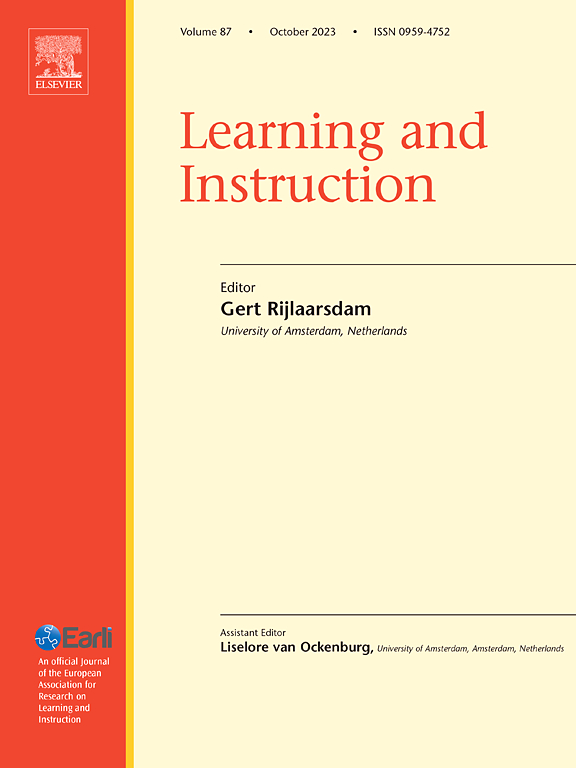Take a deep breath or screem it all out: Emotion regulation strategies of young students
IF 4.9
1区 教育学
Q1 EDUCATION & EDUCATIONAL RESEARCH
引用次数: 0
Abstract
Background
Emotion regulation (ER) is a critical component of effective self-regulated learning (SRL), which has been increasingly researched in the last decades. However, there is still insufficient empirical research on emotions and emotion regulation in early years of schooling.
Aims
This study aims to identify ER strategies of young learners, triangulate different ER measures, and investigate variables that explain variation in ER.
Sample
82 primary school students aged from 7 to 12 years (M = 10.16 (SD = 1.24); 51 % female) and their parents participated in the study.
Method
To gain deep insights into young students' ER in achievement situations, a multimodal approach was applied. In a semi-structured interview, students were asked to report their approach when facing negative emotions, low motivation or low concentration during learning. In addition, students' think-aloud during a problem-solving task, their ER self-report and their parents’ rating about ER was assessed.
Results
Results highlight the different nature of the four different ER assessment methods that measure different aspects of ER. Moreover, findings suggest that elementary school students use a range of ER strategies depending on the contexts. Furthermore, control and value beliefs regarding ER strategy use were associated with ER measured with the interview and reported in self-ratings.
Conclusion
This study offers valuable insights into how young learners regulate their negative emotions during learning, highlighting the importance of understanding factors influencing ER in young learners and why some students may not engage in ER strategies during learning. By emphasizing the need for multi-method approaches and intentional use of specific ER assessment methods beyond traditional questionnaires, the study advances the field, offering a more nuanced understanding of young learners’ ER processes within the SRL context.
深吸一口气,还是把一切都屏蔽掉:年轻学生的情绪调节策略
降级调节(ER)是有效自我调节学习(SRL)的一个重要组成部分,近几十年来得到了越来越多的研究。然而,关于早期学龄期情绪与情绪调节的实证研究仍然不足。目的本研究旨在确定青少年学习者的ER策略,对不同的ER测量方法进行三角测量,并探讨解释ER差异的变量。样本:7 ~ 12岁小学生82名(M = 10.16 (SD = 1.24);(51%为女性)和他们的父母参与了这项研究。方法采用多模式研究方法,深入了解青年学生在成就情境下的ER。在一个半结构化的访谈中,学生们被要求报告他们在学习中面对消极情绪、低动力或低注意力时的做法。此外,研究人员还评估了学生在解决问题时的大声思考、他们的ER自我报告和父母对ER的评价。结果强调了四种不同的ER评估方法的不同性质,这些方法测量了ER的不同方面。此外,研究结果表明,小学生根据不同的情境使用了一系列的ER策略。此外,关于ER策略使用的控制和价值信念与访谈测量的ER相关,并在自我评定中报告。结论本研究对青少年学习者在学习过程中如何调节消极情绪提供了有价值的见解,强调了理解影响青少年学习者消极情绪策略的因素的重要性,以及为什么有些学生在学习过程中可能不采用消极情绪策略。通过强调多方法方法的必要性,以及在传统问卷调查之外有意使用特定的ER评估方法,该研究推进了该领域的发展,为SRL背景下年轻学习者的ER过程提供了更细致入微的理解。
本文章由计算机程序翻译,如有差异,请以英文原文为准。
求助全文
约1分钟内获得全文
求助全文
来源期刊

Learning and Instruction
Multiple-
CiteScore
11.30
自引率
4.80%
发文量
109
期刊介绍:
As an international, multi-disciplinary, peer-refereed journal, Learning and Instruction provides a platform for the publication of the most advanced scientific research in the areas of learning, development, instruction and teaching. The journal welcomes original empirical investigations. The papers may represent a variety of theoretical perspectives and different methodological approaches. They may refer to any age level, from infants to adults and to a diversity of learning and instructional settings, from laboratory experiments to field studies. The major criteria in the review and the selection process concern the significance of the contribution to the area of learning and instruction, and the rigor of the study.
 求助内容:
求助内容: 应助结果提醒方式:
应助结果提醒方式:


